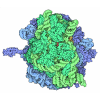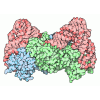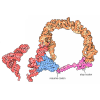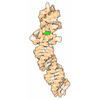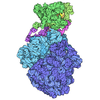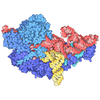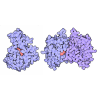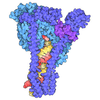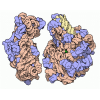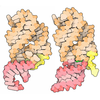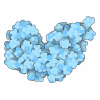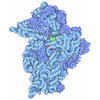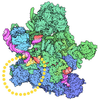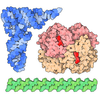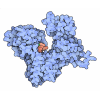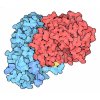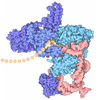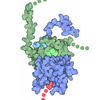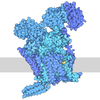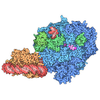+ Open data
Open data
- Basic information
Basic information
| Entry | Database: PDB / ID: 9iiy | |||||||||||||||||||||||||||||||||||||||||||||||||||||||||
|---|---|---|---|---|---|---|---|---|---|---|---|---|---|---|---|---|---|---|---|---|---|---|---|---|---|---|---|---|---|---|---|---|---|---|---|---|---|---|---|---|---|---|---|---|---|---|---|---|---|---|---|---|---|---|---|---|---|---|
| Title | Cryo-EM Structure of EfPiwi-piRNA-target (25-nt, bilobed) | |||||||||||||||||||||||||||||||||||||||||||||||||||||||||
 Components Components |
| |||||||||||||||||||||||||||||||||||||||||||||||||||||||||
 Keywords Keywords | RNA BINDING PROTEIN/RNA / Piwi protein / Pi-RNA / Argonaute / RNA BINDING PROTEIN-RNA complex | |||||||||||||||||||||||||||||||||||||||||||||||||||||||||
| Function / homology |  Function and homology information Function and homology informationregulatory ncRNA-mediated gene silencing / cell differentiation / RNA binding / cytoplasm Similarity search - Function | |||||||||||||||||||||||||||||||||||||||||||||||||||||||||
| Biological species |  Ephydatia fluviatilis (invertebrata) Ephydatia fluviatilis (invertebrata) Homo sapiens (human) Homo sapiens (human) | |||||||||||||||||||||||||||||||||||||||||||||||||||||||||
| Method | ELECTRON MICROSCOPY / single particle reconstruction / cryo EM / Resolution: 3 Å | |||||||||||||||||||||||||||||||||||||||||||||||||||||||||
 Authors Authors | Li, Z.Q. / Xu, Q.K. / Wu, J.P. / Shen, E.Z. | |||||||||||||||||||||||||||||||||||||||||||||||||||||||||
| Funding support | 1items
| |||||||||||||||||||||||||||||||||||||||||||||||||||||||||
 Citation Citation |  Journal: Nature / Year: 2025 Journal: Nature / Year: 2025Title: Structural insights into RNA cleavage by PIWI Argonaute. Authors: Zhiqing Li / Qikui Xu / Jing Zhong / Yan Zhang / Tianxiang Zhang / Xiaoze Ying / Xiaoli Lu / Xiaoyi Li / Li Wan / Junchao Xue / Jing Huang / Ying Zhen / Zhao Zhang / Jianping Wu / En-Zhi Shen /   Abstract: Argonaute proteins are categorized into AGO and PIWI clades. Across most animal species, AGO-clade proteins are widely expressed in various cell types, and regulate normal gene expression. By ...Argonaute proteins are categorized into AGO and PIWI clades. Across most animal species, AGO-clade proteins are widely expressed in various cell types, and regulate normal gene expression. By contrast, PIWI-clade proteins predominantly function during gametogenesis to suppress transposons and ensure fertility. Both clades use nucleic acid guides for target recognition by means of base pairing, crucial for initiating target silencing, often through direct cleavage. AGO-clade proteins use a narrow channel to secure a tight guide-target interaction. By contrast, PIWI proteins feature a wider channel that potentially allows mismatches during pairing, broadening target silencing capability. However, the mechanism of PIWI-mediated target cleavage remains unclear. Here we demonstrate that after target binding, PIWI proteins undergo a conformational change from an 'open' state to a 'locked' state, facilitating base pairing and enhancing target cleavage efficiency. This transition involves narrowing of the binding channel and repositioning of the PIWI-interacting RNA-target duplex towards the MID-PIWI lobe, establishing extensive contacts for duplex stabilization. During this transition, we also identify an intermediate 'comma-shaped' conformation, which might recruit GTSF1, a known auxiliary protein that enhances PIWI cleavage activity. GTSF1 facilitates the transition to the locked state by linking the PIWI domain to the RNA duplex, thereby expediting the conformational change critical for efficient target cleavage. These findings explain the molecular mechanisms underlying PIWI-PIWI-interacting RNA complex function in target RNA cleavage, providing insights into how dynamic conformational changes from PIWI proteins coordinate cofactors to safeguard gametogenesis. | |||||||||||||||||||||||||||||||||||||||||||||||||||||||||
| History |
|
- Structure visualization
Structure visualization
| Structure viewer | Molecule:  Molmil Molmil Jmol/JSmol Jmol/JSmol |
|---|
- Downloads & links
Downloads & links
- Download
Download
| PDBx/mmCIF format |  9iiy.cif.gz 9iiy.cif.gz | 152.5 KB | Display |  PDBx/mmCIF format PDBx/mmCIF format |
|---|---|---|---|---|
| PDB format |  pdb9iiy.ent.gz pdb9iiy.ent.gz | 110.6 KB | Display |  PDB format PDB format |
| PDBx/mmJSON format |  9iiy.json.gz 9iiy.json.gz | Tree view |  PDBx/mmJSON format PDBx/mmJSON format | |
| Others |  Other downloads Other downloads |
-Validation report
| Summary document |  9iiy_validation.pdf.gz 9iiy_validation.pdf.gz | 398.9 KB | Display |  wwPDB validaton report wwPDB validaton report |
|---|---|---|---|---|
| Full document |  9iiy_full_validation.pdf.gz 9iiy_full_validation.pdf.gz | 418.1 KB | Display | |
| Data in XML |  9iiy_validation.xml.gz 9iiy_validation.xml.gz | 16.2 KB | Display | |
| Data in CIF |  9iiy_validation.cif.gz 9iiy_validation.cif.gz | 25 KB | Display | |
| Arichive directory |  https://data.pdbj.org/pub/pdb/validation_reports/ii/9iiy https://data.pdbj.org/pub/pdb/validation_reports/ii/9iiy ftp://data.pdbj.org/pub/pdb/validation_reports/ii/9iiy ftp://data.pdbj.org/pub/pdb/validation_reports/ii/9iiy | HTTPS FTP |
-Related structure data
| Related structure data |  60609MC  9iizC  9ij0C  9ij1C  9ij2C  9ij3C  9ij4C  9ij5C M: map data used to model this data C: citing same article ( |
|---|---|
| Similar structure data | Similarity search - Function & homology  F&H Search F&H Search |
- Links
Links
- Assembly
Assembly
| Deposited unit | 
|
|---|---|
| 1 |
|
- Components
Components
| #1: Protein | Mass: 110611.969 Da / Num. of mol.: 1 Source method: isolated from a genetically manipulated source Source: (gene. exp.)  Ephydatia fluviatilis (invertebrata) / Gene: EfPiwiA / Production host: Ephydatia fluviatilis (invertebrata) / Gene: EfPiwiA / Production host:  Homo sapiens (human) / References: UniProt: D5MRY8 Homo sapiens (human) / References: UniProt: D5MRY8 |
|---|---|
| #2: RNA chain | Mass: 7099.259 Da / Num. of mol.: 1 Source method: isolated from a genetically manipulated source Source: (gene. exp.)  Homo sapiens (human) / Production host: Homo sapiens (human) / Production host:  Homo sapiens (human) Homo sapiens (human) |
| #3: RNA chain | Mass: 6632.997 Da / Num. of mol.: 1 Source method: isolated from a genetically manipulated source Source: (gene. exp.)  Homo sapiens (human) / Production host: Homo sapiens (human) / Production host:  Homo sapiens (human) Homo sapiens (human) |
| Has protein modification | N |
-Experimental details
-Experiment
| Experiment | Method: ELECTRON MICROSCOPY |
|---|---|
| EM experiment | Aggregation state: PARTICLE / 3D reconstruction method: single particle reconstruction |
- Sample preparation
Sample preparation
| Component | Name: EfPiwi-piRNA-target (25-nt, bilobed) / Type: COMPLEX / Entity ID: all / Source: RECOMBINANT | ||||||||||||
|---|---|---|---|---|---|---|---|---|---|---|---|---|---|
| Source (natural) |
| ||||||||||||
| Source (recombinant) | Organism:  Homo sapiens (human) Homo sapiens (human) | ||||||||||||
| Buffer solution | pH: 8 | ||||||||||||
| Specimen | Embedding applied: NO / Shadowing applied: NO / Staining applied: NO / Vitrification applied: YES | ||||||||||||
| Vitrification | Cryogen name: ETHANE |
- Electron microscopy imaging
Electron microscopy imaging
| Experimental equipment |  Model: Titan Krios / Image courtesy: FEI Company |
|---|---|
| Microscopy | Model: FEI TITAN KRIOS |
| Electron gun | Electron source:  FIELD EMISSION GUN / Accelerating voltage: 300 kV / Illumination mode: FLOOD BEAM FIELD EMISSION GUN / Accelerating voltage: 300 kV / Illumination mode: FLOOD BEAM |
| Electron lens | Mode: BRIGHT FIELD / Nominal defocus max: 2000 nm / Nominal defocus min: 1500 nm |
| Image recording | Electron dose: 50 e/Å2 / Film or detector model: TFS FALCON 4i (4k x 4k) |
- Processing
Processing
| EM software | Name: PHENIX / Category: model refinement | ||||||||||||||||||||||||
|---|---|---|---|---|---|---|---|---|---|---|---|---|---|---|---|---|---|---|---|---|---|---|---|---|---|
| CTF correction | Type: PHASE FLIPPING AND AMPLITUDE CORRECTION | ||||||||||||||||||||||||
| 3D reconstruction | Resolution: 3 Å / Resolution method: FSC 0.143 CUT-OFF / Num. of particles: 87581 / Symmetry type: POINT | ||||||||||||||||||||||||
| Refine LS restraints |
|
 Movie
Movie Controller
Controller




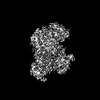


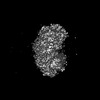


 PDBj
PDBj